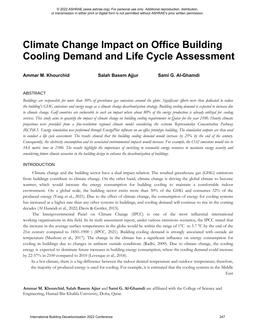Click here to purchase
Buildings are responsible for more than 30% of greenhouse gas emissions around the globe. Significant efforts were then dedicated to reduce the building’s GHG emissions and energy usage as a climate change decarbonization strategy. Building cooling demand is expected to increase due to climate change. Gulf countries are vulnerable to such an impact where about 80% of the energy production is already utilized for cooling services. This study aims to quantify the impact of climate change on building cooling requirements in Qatar for the year 2100. Hourly climatic projections were provided from a fine-resolution regional climate model considering the extreme Representative Concentration Pathway (RCP)8.5. Energy simulation was performed through EnergyPlus software on an office prototype building. The simulation outputs are then used to conduct a life cycle assessment. The results showed that the building cooling demand would increase by 25% by the end of the century. Consequently, the electricity consumption and its associated environmental impacts would increase. For example, the CO2 emissions would rise to 14.6 metric tons in 2100. The results highlight the importance of switching to renewable energy resources to maintain energy security and considering future climate scenarios in the building design to enhance the decarbonization of buildings.
Product Details
- Published:
- 2022
- Number of Pages:
- 6
- Units of Measure:
- Dual
- File Size:
- 1 file , 3.3 MB
- Product Code(s):
- D-94056-C31
- Note:
- This product is unavailable in Russia, Belarus
